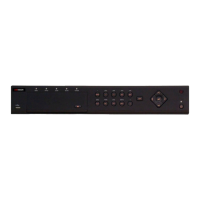
Do you have a question about the HIKVISION DS-7208HGHI-F1/N and is the answer not in the manual?
Provides essential tips for safe and proper device installation and operation, including environment and handling.
Covers features for recording, capturing images, and playing back stored data, including various recording modes.
Explains how to back up recorded data using USB/SATA devices and manage backup devices.
Details how the device handles and reports alarms and system exceptions like video loss or HDD errors.
Covers all aspects of network connectivity and remote access for the DVR, including protocols and remote operations.
Provides procedures for safely powering the DVR on and off to ensure device longevity.
Guides through the initial device activation process, including setting an admin password.
Explains how to set up and use a graphical unlock pattern for device login.
Details the initial setup wizard for basic device configuration, including language and network settings.
Covers the process of logging into and out of the DVR system for user access.
Provides steps for adding and connecting IP cameras to the DVR system for surveillance.
Explains how to configure the types of video signals accepted by the DVR channels (analog and IP).
Details various operations and functions available within the live view interface, including screen layouts and output modes.
Covers the configuration of Pan, Tilt, and Zoom settings for PTZ cameras, including protocol and parameters.
Details how to set and manage PTZ camera presets, patrols, and patterns for automated camera movements.
Sets video and audio encoding parameters for recording streams, including resolution, bitrate, and quality.
Allows setting schedules for automatic recording and picture capture based on time and event triggers.
Configures recording and capture triggered by motion detection events, including area and linkage actions.
Sets recording and capture based on external alarm inputs, including trigger channels and arming schedules.
Configures recording and capture for various VCA and alarm events like face detection or intrusion detection.
Covers manual control over recording and continuous capture, which takes priority over scheduled recording.
Enhances data safety by configuring redundant recording to a second HDD for data reliability.
Organizes multiple HDDs into groups for specific recording channel assignments, improving storage management.
Protects recorded files from overwriting by locking them or setting HDDs to read-only mode.
Covers methods for searching and playing back recorded video files using various criteria.
Explains the process of backing up recorded video and picture files to external devices like USB drives.
Details backing up files found via normal video or picture search to external storage.
Covers managing external storage devices used for backups, including creating folders and formatting.
Configures motion detection parameters, including detection area, sensitivity, and response actions.
Manages handling methods for external sensor alarms, including trigger channels and arming schedules.
Configures detection and response for video signal loss from a camera channel.
Sets up detection and response for video tampering events, such as lens obstruction.
Defines how the system responds to various exceptions like HDD errors, network disconnection, or IP conflicts.
Configures actions to be taken when an alarm or exception occurs, such as full screen monitoring or email notifications.
Configures Point of Sale (POS) integration settings, including protocol selection and character overlay.
Sets up alarms and response actions based on POS transaction events, such as recording or notifications.
Configures face detection parameters and response actions for surveillance scenes.
Configures basic network parameters like IP address, gateway, DNS, and working modes.
Covers the process of configuring RAID arrays for enhanced data redundancy and performance.
Guides on enabling the RAID function for disk arrays, either through the startup wizard or HDD management.
Guides on the essential process of initializing newly installed Hard Disk Drives before they can be used.
Adjusts various video parameters for cameras, including image settings and specific camera parameters.
Covers the process of upgrading the DVR's system firmware using local backup devices or FTP servers.
Manages user accounts, including adding, deleting, and editing users with different permission levels.
Offers solutions to common issues and problems encountered with the DVR, such as no image display or HDD errors.











